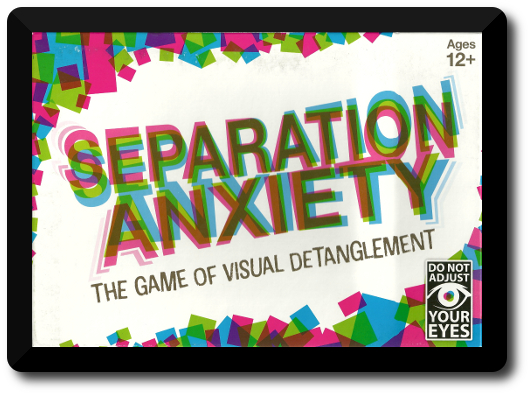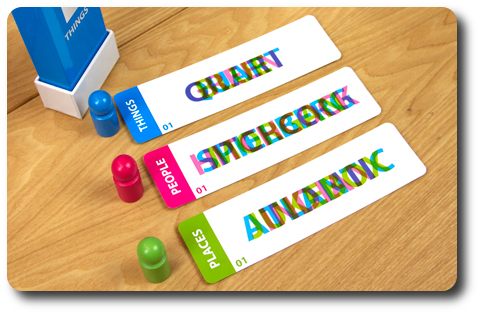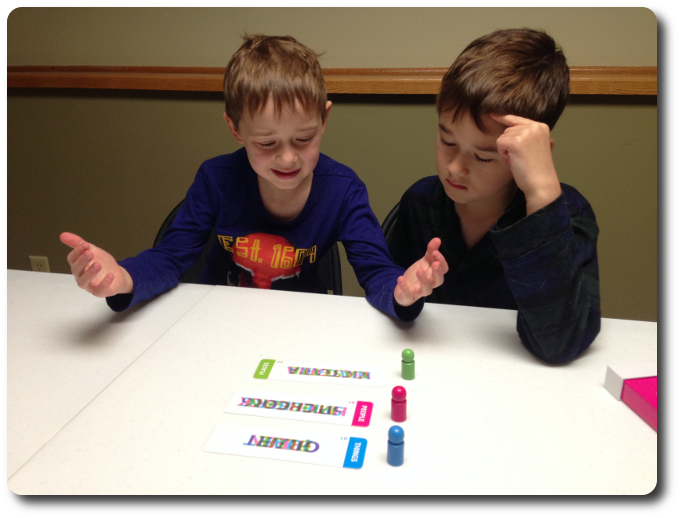
The Basics:
- For ages 8 and up (publisher suggests 12+)
- For 3 or more players
- Approximately 3o minutes to complete
Geek Skills:
- Active Listening & Communication
- Counting & Math
- Logical & Critical Decision Making
- Reading
Learning Curve:
- Child – Easy
- Adult – Easy
Theme & Narrative:
- Be the first to pull apart the words to discover the puzzle’s solution
Endorsements:
- Gamer Geek rejected!
- Parent Geek mixed!
- Child Geek rejected!
Overview
How we perceive the world around us is not the same as the person to the left or right of us. Life experience, mood, education, geographic location, and a hundred or more other aspects of what makes up the “human experience” merge to create the borders of our perception. In this game, you are asked to do two very simple things. First, identify three words. Second, determine which of the three words do not belong and why. Sound simple? It isn’t. Prepare to be separated from your comfort zone.
Separation Anxiety, original concept by Peggy Brown and published by Fat Brain Toy Company, is comprised of 150 double-sided Puzzle cards, 3 Puzzle boxes (that contain the Puzzle cards), 3 tokens (in 3 different colors), and 1 Answer Key to the puzzles. The game components are high quality, being made of sturdy card stock and wood. The Puzzle cards are housed in thick boxes that are in turn housed in a sturdy game box. Very solid. Which is good because you’ll want to throw this game against the wall from time to time.
Game Set Up
To set up the game, first remove the three Puzzle card boxes. Each box is a category. The categories include “People” (pink), “Places” (green), and “Things” (blue). Give one box to each player, starting with the youngest players.
Second, place the tokens in the middle of the playing area (pink ,green, and blue) in a row or column (based on player’s point of view).
Third, grab that Answer Key and keep it close by you. You are going to need it.
That’s it for game set up. Time to start feeling a little anxiety.
Nervous Game Play
Separation Anxiety is played in rounds. A typical round is summarized here.
Step 1: Draw 1 Puzzle Card
The players who have the Puzzle boxes now draw 1 card from the box and place it next to the matching colored token. When completed there should be 1 “People” Puzzle card, 1 “Place” Puzzle card, and 1 “Thing” Puzzle card out on the table. The Puzzle boxes are kept by the player at this time. When done, it should look something like the following image.

Step 2: Review the Puzzles
Before the players are 3 different puzzles. The players are attempting to solve as many as possible and as quickly as possible. What they are attempting to determine is what word on each Puzzle card doesn’t match based on the Puzzle card category and the majority of other words that clearly exclude the word that does not belong.
But there’s a catch…
The words are in different colors and jumbled together, bleeding over one another like so much spilled water colors. A single word might jump out at a player, but not all of them. The key here is to attempt to derive the word based on the Puzzle card category, which is only slightly easier than flat-out guessing the word.
- People Category: Includes people from specific occupations, groups, or specific individuals. Examples include George Washington and Alfred Hitchcock.
- Places Category: Specific places and landmarks. Examples include The Great Wall of China and the Indian Ocean.
- Things Category: A generic category where the excluded word will be based on the majority’s topic. Examples include Rummy and Cookies.
Step 3: Solve the Puzzles
A player “solves” the puzzle by being the first to point to the card, naming the three words, and stating how one of the words doesn’t connect to the other two. Let’s look at an example and I mean “really look at it”. See if you can identify the 3 words.

Ready for the answer? The words are “Parthenon”, “December”, and “Olympus”. The answer to the puzzle is “December”, as the name of a month is not a Greek landmark. Understand how the puzzles are solved now? Even if you don’t, the number on each Puzzle card corresponds to a listed value in the game’s Answer Key that not only identifies the words, but also describes why one of the words is excluded. Believe me when I say you’ll be referencing this answer key a great deal. It’ll become your best friend. You might even give it a name.
If the player’s answer is correct (after being checked for accuracy by an opponent), they take the token next to the Puzzle card and the round continues.
If the player correctly guesses and the player has 3 Puzzle cards of the same category already, they do not get to claim the card. Instead the player takes a Puzzle card they previously won that matches the current category and discards it. The player is now out for the duration of the round. Any opponent who was paying attention can easily claim the Puzzle card by regurgitating what the player just said.
If a player attempts to solve the puzzle, but the words were not identified correctly, a new Puzzle card is drawn to replace it.
All incorrectly guessed Puzzle cards and discarded Puzzle cards are returned to their Puzzle boxes.
When all the tokens next to the Puzzle cards are claimed, the round ends.
Continuing and Ending the Game
After the round ends, players collect the Puzzle cards they correctly solved and place the tokens back on the table. Solved Puzzle cards should be kept in front of the player, but do not need to be organized by category unless the player wants to. The Puzzle boxes are then passed to the next player to the left. A new round now begins by repeating the game set up steps and starting with step 1 noted above.
The game ends when a player collects 3 Puzzle cards from each category for a total of 9 Puzzle cards.
To learn more about Separation Anxiety, visit the game’s web page.
Final Word
The Child Geeks loathed this game. I haven’t seen so many frustrated faces around the gaming table since I attempted to explain how to play Black Friday to a group of 8-year-olds. There were two aspects of the game that really rubbed the Child Geeks the wrong way. First, the game’s concept was wildly disliked. Attempting to read purposely mixed together words felt more like work than play. Second, there were some words that were too difficult to even guess. This was primarily due to the Child Geek’s not having a robust enough vocabulary to decipher some of the partial wordage they gleaned from the Puzzle cards. According to one Child Geek, “This game is way too frustrating to ever play again.” Another Child Geek said, “It’s really challenging, to a point where I don’t think it’s any fun.” And finally one Child Geeks said, “Promise me we’ll never play this game again.” Well, OK. I guess we won’t. Separation Anxiety created more anxiety than fun, permanently separating it from any opportunity to be played by the Child Geeks again.

My two oldest Child Geeks express their confusion and mounting frustration…
The Parent Geeks were a different story. They rather enjoyed the challenge of pulling apart the words and attempting to be the first to not only see the words, but determine which one didn’t belong. According to one Parent Geek, “This is a really tricky game. Too tricky sometimes. It’s hard to get all the words, but fun trying.” Another Parent Geek felt differently and said, “This is the kind of game I dislike. It requires way too much skill which unfairly limits a player’s ability to compete, let alone participate.” It’s true. Some of the Parent Geeks spent the entire time feeling frustrated, not being able to collect enough cards to be considered a serious competitor. Some Parent Geeks considered themselves lucky to collect just one card, let alone two or three. Still, the game was seen by Parent Geeks to be a unique and challenging enough experience to welcome to their gaming table. Not enough to make it a winner, however. The Parent Geeks were undecided, proving that not everyone sees a game the same way.
The Gamer Geeks were at first excited to attempt to play the game. The idea of pulling apart words was strangely alluring to them. After they played Separation Anxiety, they couldn’t explain why they wanted to play the game in the first place. One Gamer Geek said, “Gods, what a horrible game. The colors mix up the words so much that they are too close to even read. Only a few times was I able to see anything other than a jumbled mess.” Which elicited a quick response from a nearby Gamer Geek with his words, “Which is what this game is. A big jumbled mess.” Digging deeper, I wanted to learn what exactly made this game such an atrocity. It certainly had all the elements of a decent enough Puzzle and Word game. What made it so poor? In the Gamer Geek’s eyes, it was the inability to quickly identify the words, which is the game’s point. But too many of the Gamer Geeks thought the emphasis on lack of easy readability made the game an anguishing exercise in eye squinting and second guessing. As such, none of the Gamer Geeks voted to approve Separation Anxiety.
To be fair to the game, not everyone we played it with hated it. I would say that the majority of the players simply didn’t want to play it again. That would suggest that the players had a good enough time playing the game, but didn’t feel the game warranted another play so soon after completing it. I can understand why. This game makes you work and work hard. You’ll find yourself leaning in, shaking your head to clear your eyeballs, and blinking rapidly in hopes of making the words jump out in perfectly clarity. All in vain, mind you, but you’ll do it anyway.
Technically, Separation Anxiety could be classified as a Party game, but I would caution playing this game with anymore than 4 players. Everyone will need to look really closely at the cards in an attempt to identify the words and solve the puzzle. You could, I suppose, break groups up and send different groups to the table. This would allow you to play with many more people, but would also require you to create something of a winner’s bracket, taking the winners of each group and matching them together until only 1 player remained. Again, totally possible, but it’s a lot of work for a game that is already demanding a great deal from its players.
I personally found this game to be flawed. I understand the game’s intent and appreciate the challenge, but not the way the challenge is presented. The three colors that make up the three different words merge, mingle, and blend at times to a point where it’s exceedingly difficult to determine where one letter begins and a whole word ends. You know that feeling you get when it’s raining really hard while you are driving and your windshield wipers aren’t keeping up with deluge of water on your windshield? Everything you see runs together, streaking into globs of indistinct shape. It makes you anxious and you tend to slow down, lean forward, and hope you can get through. The game is exactly like that. In short, it’s no fun and full of frustration.
No thanks.
So who in the heck is this game for? The sarcastic side of me wants to tell you “masochists”, but that is unfairly harsh and inaccurate. This is not an easy game and the level of difficulty is masked by the game’s simplistic presentation. It’s a mental and visual workout that will leave most feeling either very tired or beaten up. Most likely both. This is not a game for kids or adults. It’s a game for those who love Word games, Puzzle Games, and want to be challenged by something different by mixing the two together. Sound like a game you are interested in? Give it a shot a see. Either way, the outcome of this game and how well it will be received by your players is uncertain until you give it a try.
This game was given to Father Geek as a review copy. Father Geek was not paid, bribed, wined, dined, or threatened in vain hopes of influencing this review. Such is the statuesque and legendary integrity of Father Geek.




Looking at the sample game card on your review, I just looked at one color at a time and read each word pretty easily, taking about 17 seconds total, and then the answer was not difficult. Seems more like a visual discrimination puzzle to be played individually than a party game.